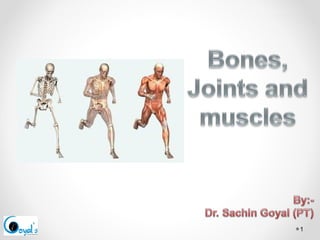Bones,joints ppt
- 1. 1
- 2. BonesBones• 206 in human body • Type of Connective tissue • Composition: protoplasm, collagen, blood vessels, marrow • Function: o support (eg) pelvic bowl, legs o protect (eg) skull, vertebrae o mineral storage (eg) calcium, phosphate, inorganic component o movement (eg) walk, grasp objects o blood-cell formation (eg) red bone marrow • Shapes of Bones o Long, Flat, Irregular, Short 2
- 3. Structure of BoneStructure of Bone 3
- 4. Joints (articulations)Joints (articulations) • Where parts of skeleton meet • Allows varying amounts of mobility • Classified by structure or function • Arthrology: study of joints 4
- 5. Joints and their ClassificationJoints and their Classification • Arthrology = study of the joints • Kinesiology = study of musculoskeletal movement • Classified by freedom of movement o diarthrosis (freely movable) o amphiarthrosis (slightly movable) o synarthrosis (little or no movement) • Classified how adjacent bones are joined o fibrous, cartilaginous, bony or synovial 5
- 6. Types of jointsTypes of joints Structure Type Example Cartilagenous Synchondrosis Symphysis Epiphyseal plates Intervertebral discs Fibrous Sutures Syndesmoses Gomphosis Skull Distal Tibia/fibula Teeth in sockets Synovial Uniaxial Biaxial Ball and socket Glenohumeral joint Knee joint TMJ 6
- 7. Components of Synovial JointsComponents of Synovial Joints • Articular cartilage: hyaline; covers ends of both bones articulating • Synovial (joint) cavity: space holding synovial fluid • Articular capsule: Made of 2 layers o Fibrous: external, dense CT for strength o Synovial membrane: internal, produces synovial fluid • Synovial fluid: viscous; lubricates and nourishes; contained in capsule and articular cartilages • Reinforcing ligaments: extra-capsular/intra-capsular • Nerves + vessels: Highly innervated, Highly vascular • Meniscus (some): fibrocartilage; improves the fit of 2 bones to increase stability 7
- 8. Synovial Joint structureSynovial Joint structure 8
- 9. Types of Synovial JointsTypes of Synovial Joints 9
- 10. MusclesMuscles • a soft tissue found in most animals. • Types: 1) Smooth muscle - controlled by the autonomic nervous system; may either be generally inactive and then respond to neural stimulation or hormones or may be rhythmic 2) Cardiac muscle - found in the heart, acts like rhythmic smooth muscle, modulated by neural activity and hormones 3) Skeletal muscle - move us around and responsible for most of our behavior; most attached to bones at each end via tendons • Function: 1) movement 2) maintain posture 3) joint stability 10
- 11. Special Features of MuscleSpecial Features of Muscle • Contractibility = cells generate pulling force • Excitibility = nervous impulses travel through muscle plasma membrane to stimulate contraction • Extensibility = after contraction muscle can be stretched back to original length by opposing muscle action • Elasticity = after being stretched, muscle passively recoils to resume its resting length 11
- 12. Muscle Basics toMuscle Basics to RememberRemember • 3 Types: Skeletal, Cardiac, Smooth • Origin vs. Insertion • Direct vs. Indirect Attachments o direct = right onto bone o indirect = via tendon/aponeurosis • more common • leave bony markings = tubercle, crest, ridge, etc. • Sometimes attach to skin 12
- 13. Arrangements of Muscle FasciclesArrangements of Muscle Fascicles 13
- 14. 14














